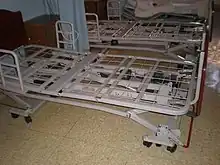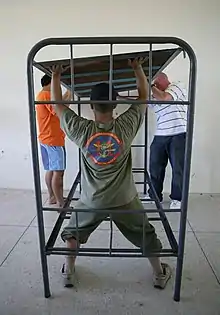
A bed frame[1] or bedstead[2] is the part of a bed used to position the bed base, the flat part which in turn directly supports the mattress(es). The frame may also stop the matresses from sliding sideways, and it may include means of supporting a canopy above. Bed frames are typically made of wood or metal. A bed frame includes head, foot, and side rails.[1] The majority of double (full) beds and all queen and king-sized beds necessitate a central support rail, often accompanied by additional feet that extend towards the floor for stability. The concept of a "bed frame" was initially introduced and referred to between 1805 and 1815.[1][3] This foundational support system not only reinforces the structure of the bed but also ensures its durability and longevity, distributing weight evenly to prevent sagging and enhance overall comfort. Not all beds include frames; see bed base.
Brass beds
Brass beds are beds in which the headboard and footboard are made of brass; the frame rails are usually made of steel. Brass beds can be made of 100 per cent brass or of metals that have been brass-plated. The brass used in making brass beds is usually 70 per cent copper and 30 per cent zinc. The ratio of metals may vary between manufacturers.
.jpg.webp)
Initially, brass beds boasted a minimalist and straightforward design. Throughout the centuries, designs have become increasingly elaborate and can contain extensive ornamentation, such as porcelain finials. Some brass bed styles include traditional, Art Deco, Victorian, transitional, Edwardian and contemporary.[4]

Iron beds
Iron beds are beds in which the headboard and footboard are made of iron; the frame rails are usually made of steel. Iron beds were developed in 17th century Italy to address concerns about infestation by bed bugs and moths. An iron cradle (with dangerously pointed corner posts) has been dated to 1620–1640.[5] From the start of their production in the 1850s until World War I, iron beds were handmade. The manufacturing process included hand pouring and polishing intricately detailed casting and hand applying finishes. In the many small foundries of the time that employed only a handful of employees, it could take days to produce a single bed.
Following the conclusion of World War I, the methodologies employed for mass production during the war had a substantial impact on the iron industry. The erstwhile handmade craftsmanship gradually yielded to the adoption of cost-efficient mass production techniques.
Today's iron beds are constructed of cold roll, heavy-gauge steel tubing and solid bar stock.[6]
Almost all iron beds now have a beech wood sprung slatted base in a steel framework which gives support to all types of mattresses.
Wooden drawer beds
Wooden drawer beds encompass a category of beds characterized by their incorporation of drawers within the wooden framework. These beds feature a wooden structure resembling a box, designed to accommodate the mattress within a carved-out space while incorporating drawers beneath the mattress area.
See also
- Storage bed, a bed with built in storage, usually as part of the bed frame
References
- 1 2 3 "Bed frame". Dictionary.com. Archived from the original on 2014-04-08. Retrieved 2012-05-26.
- ↑ "Bedstead". Dictionary.com. Retrieved 2012-05-26.
- ↑ "All you need to know about the history of beds". historyofbeds. Retrieved 2024-01-10.
- ↑ Wauntour, Paul (2018-12-12). "A History of Brass & Iron Bedsteads". Bed Interiorsecrets. Retrieved 2023-08-02.
- ↑ George Himmelheber (May 2, 2003). Cast-Iron Furniture. Philip Wilson Publishers. p. 18. ISBN 9780856674624. OL 8302167M. 0856674621.
- ↑ "Your Mattress Could Be Harmful by Acting as a Radiation Antenna". Heveya. Retrieved 2023-08-02.